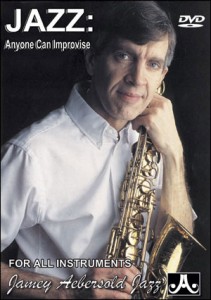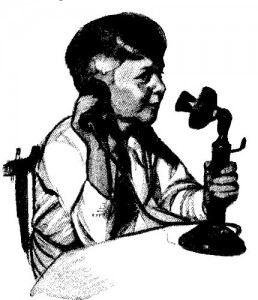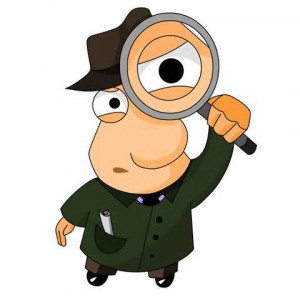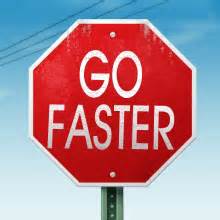As I strip away the cellophane covering, the first thing I notice is Jamey’s fabulous hair! It’s so dark and full… Anyway… In all seriousness, I open the case and there is a small booklet in the front cover. It says, “Note: This DVD contains much information!” No kidding… it goes on to say on the front,
“Don’t feel like you have to grasp and understand everything in the first viewing. Take your time in digesting the various concepts and ideas. You may want to view it in sections. If there are things you don’t understand please feel free to contact me.” – Jamey Aebersold
For those of you who were un-aware, if you do the practice exercises in the FQ Red Handbook and mail them to Jamey, he will actually grade them and send it back to you. Jamey’s mailing info can be found on Jazzbooks.com. This little booklet is just an abridged version of the Nomenclature, Jamey’s talk on jazz as the “Natural Music,” Practice Methods for beginning scales and chords, and an introduction to the scale syllabus.
Finally, I actually start the DVD.
The video opens with Jamey playing a wonderfully improvised solo on his saxophone. After a brief introduction, we move over to the piano. Jamey explains the the keyboard is an important instrument, not just for the sound of jazz, but also to jazz instruction, so that’s where shall spend most of this video.
Once again, Jamey let’s us know that anyone can improvise!
I have never met a person who couldn’t improvise! I have met people who think they can’t. Your mind is the builder and what you think… you become. A positive mental attitude contributes much to successful improvisation!
He gives us examples of how easy it is to improvise. Playing wrong notes and getting lost are the two main fears people have when playing jazz. So, he plays wrong notes on purpose, and shows us how to recover simply. He sings melodies that he hears in his mind, then mimics them on the keyboard. As for keeping your place in the tune, all you have to do is count. Jazz musicians will memorize chord progressions and patterns, but will always be counting in their minds. Eventually, counting will become so natural, you forget you are doing it! The same way as when you walk. At one point, you had to thing to put one foot in front of the other, but now it’s the easiest thing in the world.
Next, Jamey plays tracks from several play-a-longs, pulls out the lead sheet, and points out the chord changes as they come by. He encourages you to count along, clap at the beginning of phrases, and to try to hear the changes as they occur.
Jamey moves onto to talking about the importance of learning and practicing scales. He starts another track, and plays a major scale, arpeggiates it, plays it in thirds, then a minor scale, and does a similar progression, and keeps playing different scales. Finally, he uses all the different modes and shapes he just showed us to improvise a little with the track.
Answer The Phone!
Your telephone rings, you pick it up and answer it, “Hello?” The person on the other end says, “Hi, Patrick,” and you know it’s your mom. How did you know that? Well, you might have cheated and looked at the caller ID (if your phone has it), but more than likely, you recognized the sound of your mom’s voice. Ear training is just the same. When you spend enough time hearing these scales, chords, embellishments, and tunes, you begin to recognize them just by their sound alone. You begin to understand and anticipate where chords will go. Obviously, to become highly proficient, you must constantly be practicing. Jamey plays through several exercises, challenging the the viewer to figure out and follow what he is playing. “You might want to sing it” Jamey says. I think I’ll pass on that one…
If you practice the scales you can use in a tune beforehand, it will help you to improvise fluently. Often, Jamey says, if you fail to do this, you’ll forget your scales/fingerings/whatnot, mess up, become discouraged and say, “I knew it, I can’t play jazz!” when in reality, you can. Another tool you can use to strengthen your improvising arsenal is repetition. It builds tension, but also gives you time to decide where to go next in your improvisation.
What It Looks Like
Jamey starts another track, but for this track, he has overdubbed his own saxophone playing. As it plays, he continues to point out were we are in the tune, as well as informing us which scales and patterns he is playing that coincide with with the track. After the track is finished, he explains how something that started out so simple (relatively speaking), became increasingly complex as the tune went on. It is the system that Jamey recommends for most tunes. He plays a few more improvised solos to show you what he means in more detail.
Faster, Faster, Faster!
Everyone starts slow. The jazz masters started slow. They have even recorded slow tunes, as well as ones that are fast. Jamey warns against forgetting to work on both. It’s good to learn things slowly, but if you only ever practicing everything slowly, you’ll eventually be wasting your time. Work up your speed, and eventually it will come.
To Jamey, A very important aspect of jazz education having some keyboard knowledge, even if it is only two or three note chord voicings. The harmony in these chords helps you understand the relationships between intervals.
Jamey finishes by saying if there is one thing he would like you to take away from this DVD, it’s this,
Listen to the jazz masters.
He goes on to say how he began his record collection around the age of 11. Listening to jazz masters is one of the best ways to develop a jazz vocabulary and ear.
In many ways, this DVD is a distilled, compact version of the information given in Volume 1, How To Play Jazz And Improvise. It also shows you exactly how you can use an Aebersold play-a-long to your greatest advantage. It really is a wonderful resource for any jazz musician.




